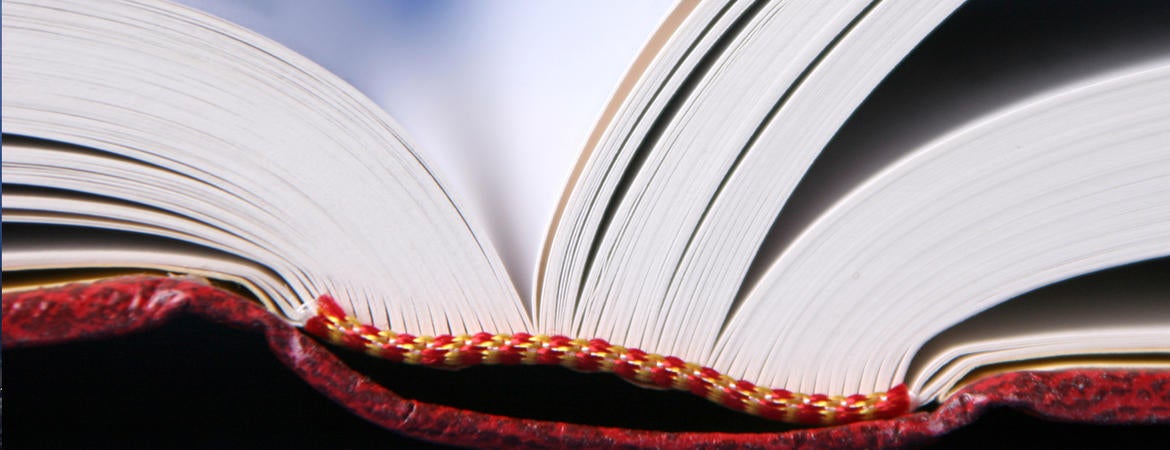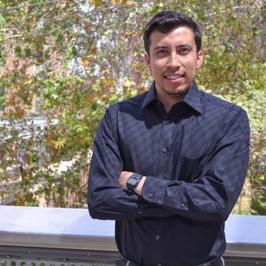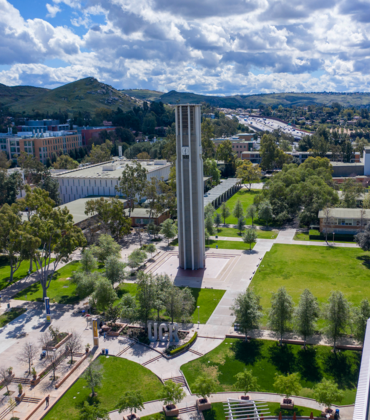
To a kid growing up in Santa Ana’s immigrant community, the pursuit of a college degree seemed like a distant possibility and a Ph.D. seemed downright fanciful. But with his parents’ passionate support and the guidance of faculty and student mentors, Vicente Robles leaped many hurdles to become the first in his family to receive a Bachelor’s degree, and to go on to conduct research as a Ph.D. student of mechanical engineering in the Marlan and Rosemary Bourns College of Engineering at UC Riverside. Robles’ list of accomplishments can now include the honor of a 2018 Ford Foundation Predoctoral Fellowship.
The $24,000 fellowship will support Robles’ effort to develop a new method to deliver therapeutic agents, such as drugs or genes, directly into living cells. Current methods for introducing foreign materials into cells, known as transfection, rely on puncturing the outer membrane with a laser, which risks heat damage to the cell, or a pipette, which risks contamination.
Robles aims to improve the process by taking advantage of optical cavitation, which uses a laser to form bubbles in a liquid that expand rapidly then collapse. One bubble collapses faster and pierces the neighboring bubble. He believes that, if forceful enough, the microscopic jet can also pierce a cell membrane and be used to transfect the cell. With his Ford Fellowship, he will study the thermal effects, fluid dynamics, and viability of cells treated with two-bubble jetting to determine the effectiveness of this approach.
“The last technique someone may consider for safe and efficient cellular drug delivery is using bubbles, but the process of cavitation generates strong, local changes in mechanical properties of the surrounding medium,” Robles said. “I am currently using these bubbles and their emitted shockwaves to enhance localized surface cooling of materials. As I observe and continue researching these bubbles, I am excited for their potential to perforate cells with micro-jets that can be precisely controlled with the laser parameters.”
“The research that Vicente is conducting is a logical extension of previous studies we started in my laboratory about 6 years ago,” said Robles’ advisor, Guillermo Aguilar, professor and chair of mechanical engineering. “Vicente’s background in physics is a great asset to the lab. At the same time, the objective he pursues of using laser-induced cavitation bubbles and its subsequent microscopic jet to pierce the cell membrane and transfect cells is very ambitious and has potential biological and biomedical applications.”
Robles’ path to engineering wasn’t always assured.
“My Mexican immigrant parents have served their time working in large warehouses and hotel maintenance and have also experienced periods of unemployment. In my hometown, the blue-collar working lifestyle is standard among the majority immigrant community. Higher education on the other hand, is unusual. This reality affected my early goals,” he explained.
In high school, Robles was a scholar at the Henry T. Nicholas Academic Center, which provides underprivileged high school students with the support necessary to achieve their full scholarly potential. The Center familiarized Robles with the Claremont University Consortium and supported him throughout the application process for Pomona College.
At Pomona College, Robles mentored first-generation students and helped establish the Claremont University Consortium chapter of the Society for Advancement of Chicanos/Hispanics and Native Americans in Science. During his final year, he helped solidify a new partnership between Pomona’s physics department and “The Femineers”, a public high school club of predominantly low-income and underrepresented female students. He designed a project to introduce the fundamentals of coding, actuators, and sensors that The Femineers then used to build autonomous robots capable of playing musical chairs.
Robles is active in the Society of Hispanic Professional Engineers at UCR, where he is helping with "Noche de Ciencias" (“Night of Science”), an event held later this month to promote interest in STEM fields among Latino middle school students and parents in bilingual settings.
Through its Fellowship Programs, the Ford Foundation seeks to increase the diversity of the nation’s college and university faculties by increasing their ethnic and racial diversity, to maximize the educational benefits of diversity, and to increase the number of professors who can and will use diversity as a resource to benefit all students. Ford Fellows are eligible to attend the Conference of Ford Fellows, a prestigious national conference of a select group of high-achieving scholars.
“Vicente is hard-working, full of ambition, and well poised to become an excellent independent researcher. Being the humble, balanced individual he is, many students and colleagues are enthusiastic to work with Vicente. I have no doubt he will be a well-rounded academic by the time he finishes his studies with the help of the Ford Foundation Fellowship,” said Aguilar.
Robles plans to pursue a career as a professor and, in addition to his research, continue to participate in programs designed to support first-generation and underrepresented students.
“The Ford Foundation Fellowship will give me the freedom to pursue the ideas I believe are most academically promising and will allow me to make strides toward my goal of enriching academia with greater diversity,” Robles said.




